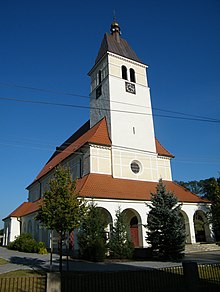Friedrichsthal (Murow)
| Friedrichsthal Zagwiździe |
||
|---|---|---|

|
|
|
| Basic data | ||
| State : | Poland | |
| Voivodeship : | Opole | |
| Powiat : | Opole | |
| Gmina : | Murow | |
| Geographic location : | 50 ° 52 ' N , 17 ° 59' E | |
| Residents : | 773 (December 31, 2017) | |
| Postal code : | 46-030 | |
| Telephone code : | (+48) 77 | |
| License plate : | OPO | |
Friedrichsthal ( Polish Zagwiździe ) is a village in Upper Silesia in the municipality Murow in the Powiat Opolski in the Opole Voivodeship .
geography
Geographical location
Friedrichsthal is located one kilometer northeast of the municipality Murow and 25 kilometers north of the district town and voivodeship capital Opole ( Oppeln ). The Budkowitzer Bach flows through Friedrichsthal, which widens into a hut pond and from which a canal branches off.
Neighboring places
Neighboring places of Friedrichsthal are in the north Zedlitz ( Grabice ), in the east the hamlets Morczinek ( Morcinek ) and Alt Budkowitz ( Stare Budkowice ) and in the west Murow ( Murów ).
history
The Friedrichsthal settlement was built in the first half of the 18th century. In 1755 24 families lived in the village, 17 of them came from the area, two from Saxony and one from Austria and four families were Hussites. The village of Kreuzburgerhütte (older spelling: Creutzburgerhütte or Creuzburgerhütte), named after the city of Kreuzburg, was originally located north of Friedrichsthal . Today, Kreuzburgerhütte is part of the town of Friedrichsthal.
In 1769 the Creutzburger Hütte founded a miners' school as a so-called simultaneous school. H. Protestant and Catholic pupils were taught together by the employed teacher of the state hut. The school was subordinate to the Protestant pastor von Carlsruhe.
In 1784 a Catholic school was founded. In 1865 the place had 48 colony and 72 cottage positions. In 1784 the Knappschaftsschule became a Protestant school.
In 1819 the school supervision was passed from the pastor in Carlsruh to the pastor from Kupper. The Protestant school moves into a new, permanent house; From now on, the classroom will also serve as a church room, will have a pulpit altar and an organ. In 1845 a church building with a tower and bells was added, which was built in the Frederician style similar to the one in Malapane. It stood until January 21, 1945.
In the referendum on March 20, 1921, 926 eligible voters voted to remain with Germany and 211 for Poland. Friedrichsthal remained with the German Empire. Until 1945 the place was in the district of Opole .
In 1945 the previously German place came under Polish administration and joined the Silesian Voivodeship. On December 16, 1946 the place was renamed Zagwiździe . In 1950 Zagwiździe became part of the Opole Voivodeship and in 1999 the re-established Powiat Opolski . In March 2009, the place was also given the official German place name Friedrichsthal .
Sights and monuments
- Botanical Garden - laid out in 2006 and has a large number of rhododendrons .
- Catholic Herz-Jesu-Kirche - built in the years 1920 to 1921 with influences of the Italian Renaissance. Consecrated on October 8, 1932.
- Neo-Gothic path chapel
- Modern path chapel
- Monument to the fallen with a sculpture of a fallen man lying down and a standing figure of a mourning woman
- Several industrial monuments with a museum hall
societies
- German Friendship Circle
- Volunteer firefighter
- Sports club FC Zagwiździe / Friedrichsthal
Sons and daughters of the place
- Johann Friedrich Krigar (born November 21, 1774 - April 1, 1852), German locomotive builder
Web links
Individual evidence
- ^ Residents of Murow, December 31, 2017
- ↑ a b cf. Felix Triest: Topographisches Handbuch von Oberschlesien , Breslau 1865
- ↑ See results of the referendum in Upper Silesia of 1921 ( Memento from January 15, 2017 in the Internet Archive )
- ^ Ordinance of November 12, 1946





